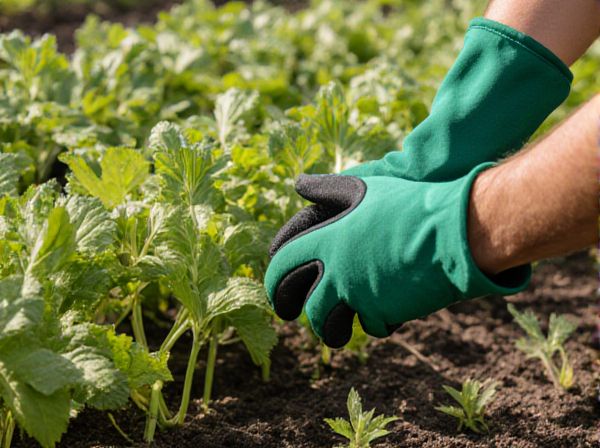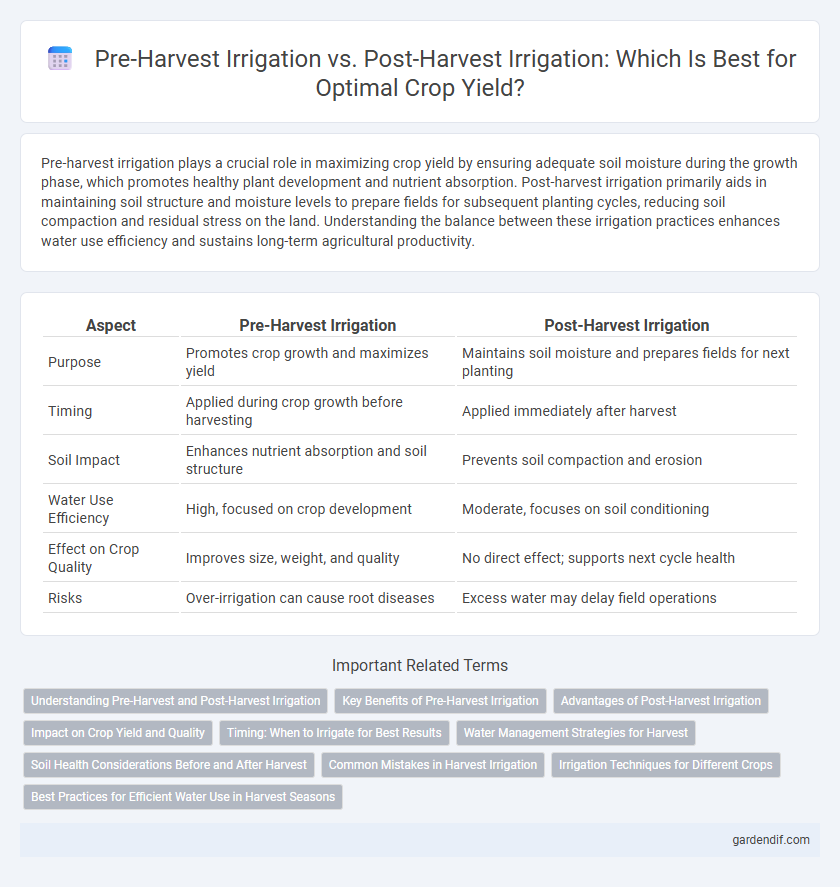
Pre-Harvest Irrigation vs Post-Harvest Irrigation Illustration
Pre-harvest irrigation plays a crucial role in maximizing crop yield by ensuring adequate soil moisture during the growth phase, which promotes healthy plant development and nutrient absorption. Post-harvest irrigation primarily aids in maintaining soil structure and moisture levels to prepare fields for subsequent planting cycles, reducing soil compaction and residual stress on the land. Understanding the balance between these irrigation practices enhances water use efficiency and sustains long-term agricultural productivity.
Table of Comparison
| Aspect | Pre-Harvest Irrigation | Post-Harvest Irrigation |
|---|---|---|
| Purpose | Promotes crop growth and maximizes yield | Maintains soil moisture and prepares fields for next planting |
| Timing | Applied during crop growth before harvesting | Applied immediately after harvest |
| Soil Impact | Enhances nutrient absorption and soil structure | Prevents soil compaction and erosion |
| Water Use Efficiency | High, focused on crop development | Moderate, focuses on soil conditioning |
| Effect on Crop Quality | Improves size, weight, and quality | No direct effect; supports next cycle health |
| Risks | Over-irrigation can cause root diseases | Excess water may delay field operations |
Understanding Pre-Harvest and Post-Harvest Irrigation
Pre-harvest irrigation is essential for maximizing crop growth by maintaining optimal soil moisture, which directly influences yield and quality. Post-harvest irrigation helps in soil moisture replenishment, reducing plant stress and supporting residue decomposition for future planting cycles. Both irrigation strategies are vital for sustainable water management and enhancing overall agricultural productivity.
Key Benefits of Pre-Harvest Irrigation
Pre-harvest irrigation ensures optimal soil moisture levels, promoting maximum crop growth and yield by supporting nutrient absorption and reducing plant stress. It enhances grain quality and weight by maintaining consistent hydration during critical developmental stages. Proper timing of irrigation before harvest minimizes the risk of drought-induced damage and improves overall crop resilience.
Advantages of Post-Harvest Irrigation
Post-harvest irrigation enhances soil moisture retention, promoting nutrient absorption and improving subsequent crop yields. It reduces plant stress and accelerates recovery, ensuring healthier root systems for future growth cycles. Maintaining consistent moisture after harvest also minimizes soil erosion and nutrient depletion, supporting sustainable farming practices.
Impact on Crop Yield and Quality
Pre-harvest irrigation ensures optimal soil moisture levels, directly enhancing crop yield by promoting consistent growth and reducing stress during critical development stages. Post-harvest irrigation, however, primarily supports soil nutrient replenishment and prepares fields for subsequent planting, indirectly influencing future crop quality rather than immediate yield. Balancing these irrigation practices maximizes both current harvest volume and long-term soil health, crucial for sustained agricultural productivity.
Timing: When to Irrigate for Best Results
Pre-harvest irrigation is critical for maximizing crop yield and quality by ensuring optimal soil moisture during the crucial growth stages, typically ceasing a few days before harvest to prevent fruit splitting and disease. Post-harvest irrigation supports soil moisture replenishment and aids in preparing the field for subsequent planting cycles, improving nutrient uptake and soil structure. Timing irrigation based on crop-specific water needs and local climate conditions ensures efficient water use and enhances overall farm productivity.
Water Management Strategies for Harvest
Pre-harvest irrigation plays a crucial role in optimizing soil moisture levels to enhance crop growth and maximize yield, while post-harvest irrigation primarily aids in maintaining soil structure and preventing moisture stress in perennial crops. Efficient water management strategies during these phases involve precise scheduling based on crop water requirements, soil moisture monitoring technologies, and climate data to reduce water waste. Implementing these targeted irrigation practices improves water use efficiency, supports sustainable agriculture, and mitigates risks associated with drought and crop loss.
Soil Health Considerations Before and After Harvest
Pre-harvest irrigation plays a crucial role in maintaining optimal soil moisture, which supports healthy root development and nutrient uptake essential for crop yield. Post-harvest irrigation helps replenish soil moisture depleted during the growing season, preventing soil compaction and promoting microbial activity critical for organic matter decomposition. Effective management of irrigation timing enhances soil structure, minimizes erosion risk, and sustains long-term soil fertility for future planting cycles.
Common Mistakes in Harvest Irrigation
Common mistakes in harvest irrigation include overwatering during pre-harvest phases, leading to root diseases and reduced crop quality, and inadequate post-harvest irrigation, which compromises soil moisture levels essential for regrowth. Ignoring crop-specific water requirements and timing irrigation improperly can cause yield loss and increase susceptibility to pests. Maintaining balanced soil moisture through precise irrigation scheduling is critical for optimizing harvest outcomes and sustaining soil health.
Irrigation Techniques for Different Crops
Pre-harvest irrigation techniques such as drip irrigation and furrow irrigation optimize soil moisture levels to enhance crop growth and yield for crops like maize, wheat, and rice. Post-harvest irrigation primarily involves controlled water application to maintain soil health and support subsequent crop cycles, commonly used in orchards and plantations such as citrus and tea. Selecting appropriate irrigation methods based on crop type ensures efficient water use and maximizes productivity throughout the agricultural cycle.
Best Practices for Efficient Water Use in Harvest Seasons
Pre-harvest irrigation ensures optimal soil moisture for crop development, enhancing yield quality and uniformity, while post-harvest irrigation aids in soil moisture replenishment and mitigates water stress on residual roots. Efficient water use during harvest seasons involves scheduling irrigation based on soil moisture data and crop water requirements to avoid overwatering and reduce water loss. Implementing drip irrigation and soil moisture sensors maximizes water efficiency, supporting sustainable harvest practices and conserving water resources.
Pre-Harvest Irrigation vs Post-Harvest Irrigation Infographic

 gardendif.com
gardendif.com